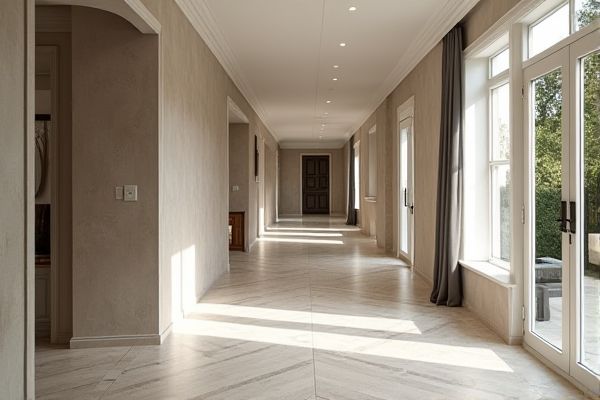
Tile flooring offers durability and a classic, high-end appearance ideal for moisture-prone areas, while vinyl flooring provides a cost-effective, softer, and more versatile option with simpler installation and maintenance. Explore the rest of the article to discover which flooring choice best suits your lifestyle and design preferences.
Table of Comparison
| Feature | Tile Flooring | Vinyl Flooring |
|---|---|---|
| Material | Ceramic, Porcelain, or Natural Stone | PVC (Polyvinyl Chloride) with various finishes |
| Durability | Highly durable, scratch and heat resistant | Moderately durable, resistant to scratches but less heat resistant |
| Installation | Labor-intensive, requires grout and mortar | Easy, peel-and-stick or click-lock options available |
| Water Resistance | Excellent, suitable for wet areas | Excellent, waterproof suitable for bathrooms and kitchens |
| Maintenance | Low maintenance, needs regular cleaning and grout sealing | Very low maintenance, simple cleaning with mild detergents |
| Comfort | Hard and cold underfoot | Softer, warmer, more comfortable to stand on |
| Cost | Higher upfront cost, long-term value | Lower upfront cost, moderate lifespan |
| Lifespan | 20+ years with proper care | 10-20 years depending on quality |
| Design Variety | Extensive, natural textures and patterns | Wide range, including realistic wood and stone looks |
Introduction to Tile and Vinyl Flooring
Tile flooring offers exceptional durability and a variety of styles, making it ideal for high-traffic areas and moisture-prone spaces. Vinyl flooring provides a cost-effective, water-resistant option with easy installation and a range of designs mimicking natural materials. Your choice depends on factors like budget, maintenance, and room function.
Material Composition and Construction
Tile flooring is typically made from natural materials such as ceramic, porcelain, or stone, offering durability and resistance to moisture through a dense, hard composition. Vinyl flooring consists of synthetic materials, primarily polyvinyl chloride (PVC) layers, combined with plasticizers to provide flexibility and water resistance, making it lighter and easier to install. Your choice between tile and vinyl depends on the desired balance of natural aesthetics versus ease of maintenance and installation.
Aesthetic Options and Design Versatility
Tile flooring offers a wide range of aesthetic options including various colors, patterns, textures, and finishes that can mimic natural stone, wood, and intricate mosaics, providing high design versatility for both classic and modern interiors. Vinyl flooring presents an equally diverse selection of styles and patterns, often replicating expensive materials with ease, while offering flexibility in installation and maintenance. Your choice between tile and vinyl flooring will depend on whether you prioritize the premium look and durability of tile or the versatile, cost-effective design options available with vinyl.
Durability and Wear Resistance
Tile flooring offers exceptional durability and wear resistance, making it ideal for high-traffic areas and environments prone to moisture or heavy use. Vinyl flooring provides a resilient surface with good wear resistance, but it may be more susceptible to scratches or dents over time compared to tile. Your choice depends on the balance you seek between longevity, maintenance, and floor performance in your space.
Water and Moisture Resistance
Tile flooring offers superior water and moisture resistance, making it ideal for bathrooms, kitchens, and basements where exposure to water is frequent. Vinyl flooring also provides excellent moisture resistance with waterproof options that prevent warping and mold growth in high-humidity areas. Both materials protect subfloors from water damage, but tile's impermeable surface outperforms vinyl in long-term durability against standing water.
Installation Process and Complexity
Tile flooring installation requires precise surface preparation, cutting, and grout application, making it a time-intensive and skill-demanding task often best handled by professionals. Vinyl flooring offers a simpler installation process with options like peel-and-stick or click-lock planks that can be easily installed over existing subfloors with minimal tools and expertise. This reduced complexity and faster installation time make vinyl flooring a popular choice for DIY projects and budget-conscious homeowners.
Comfort and Underfoot Feel
Tile flooring offers a hard, cool surface that can feel cold and unforgiving underfoot, often requiring area rugs for added comfort. Vinyl flooring provides a softer, more cushioned feel with slight flexibility that reduces fatigue during prolonged standing. The thermal properties of vinyl help maintain a warmer surface temperature, enhancing overall comfort in living spaces.
Maintenance and Cleaning Requirements
Tile flooring requires regular sweeping and mopping with mild detergents to prevent grout buildup and maintain its durability, while vinyl flooring is easier to clean, needing only occasional sweeping and damp mopping to keep it looking fresh. Tile grout can stain and may need periodic sealing, whereas vinyl's seamless surface resists stains and moisture more effectively. Your choice depends on whether low-maintenance convenience or the robust resilience of tile fits your lifestyle best.
Cost Comparison and Budget Considerations
Tile flooring typically costs between $5 and $15 per square foot, including materials and installation, making it a higher upfront investment compared to vinyl flooring, which ranges from $2 to $7 per square foot. Vinyl flooring offers budget-friendly options with lower installation expenses and easier DIY application, making it ideal for cost-conscious projects. Long-term costs, such as maintenance and durability, also favor tile flooring due to its extended lifespan and resistance to wear, potentially providing better value despite initial price differences.
Environmental Impact and Sustainability
Tile flooring, often made from natural materials like clay and sand, has a long lifespan and can be recycled, reducing landfill waste and environmental impact. Vinyl flooring, derived from synthetic materials like PVC, has a higher carbon footprint due to petrochemical production and poses challenges in recycling, often contributing to plastic pollution. Choosing tile flooring supports sustainability efforts by promoting durability and recyclability, while vinyl flooring's environmental effects depend heavily on manufacturing practices and end-of-life disposal options.
 homyna.com
homyna.com